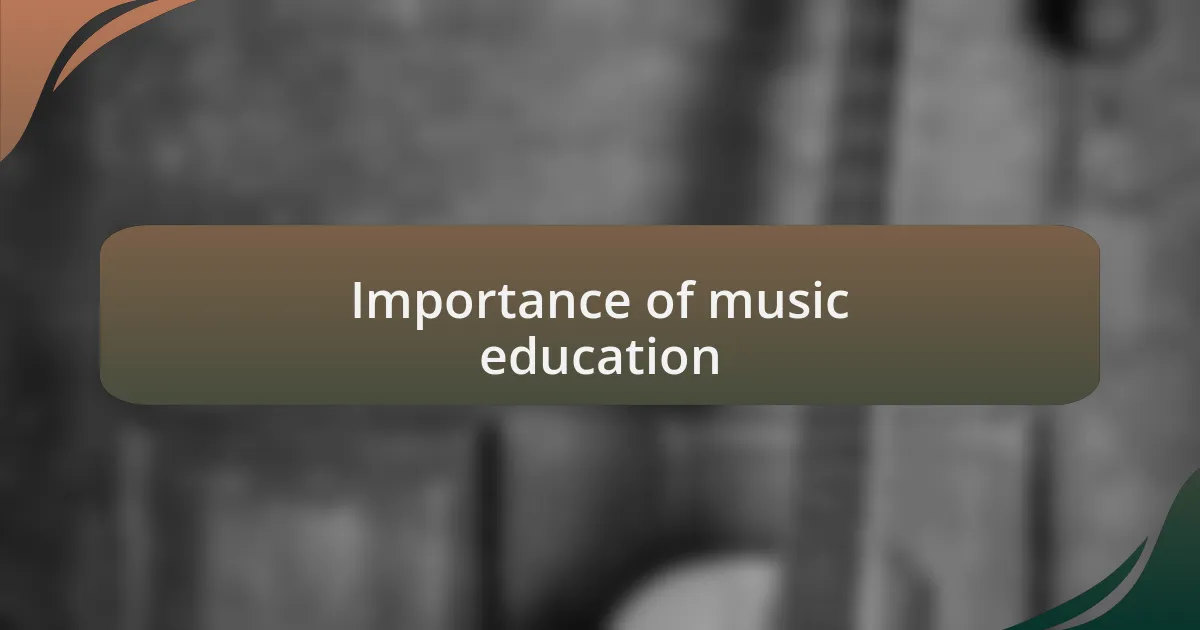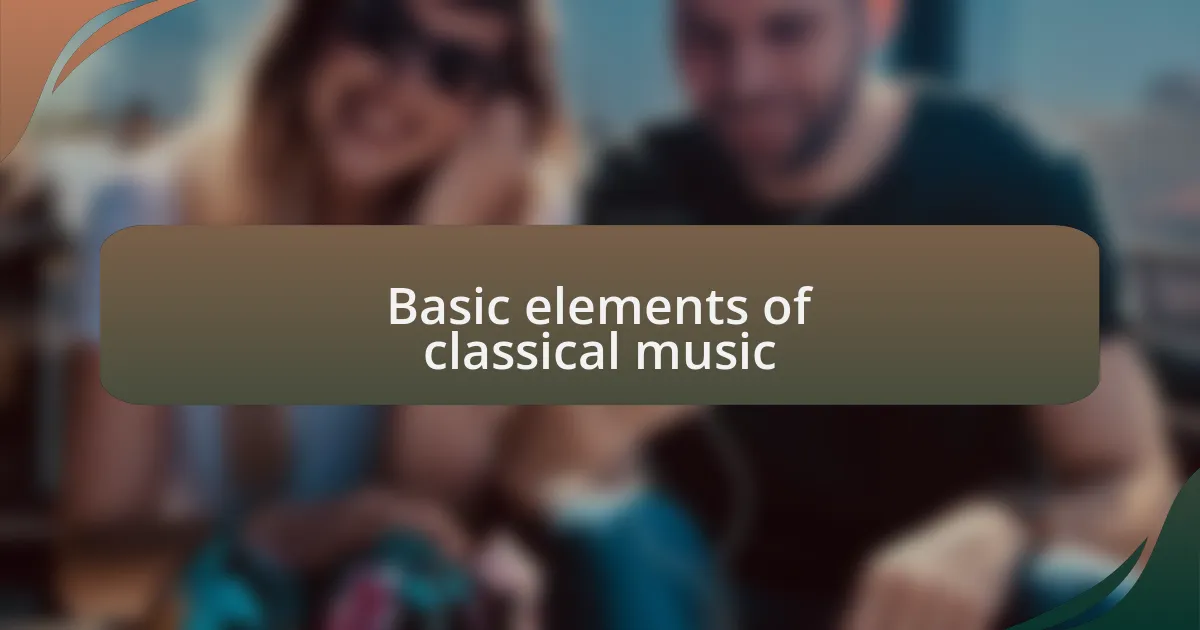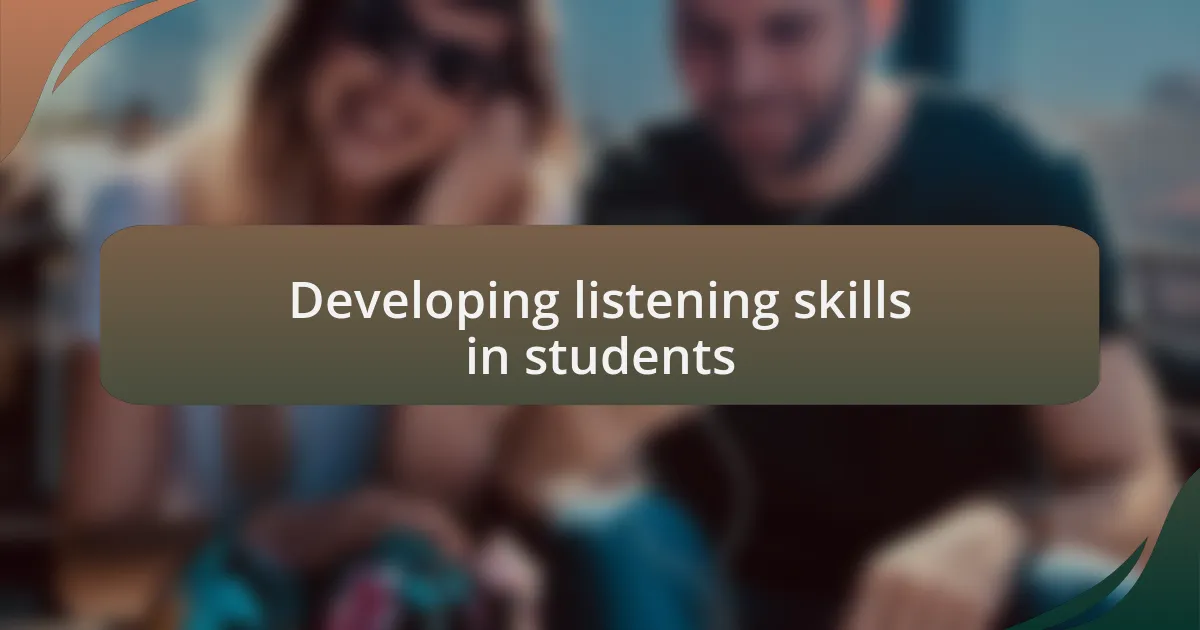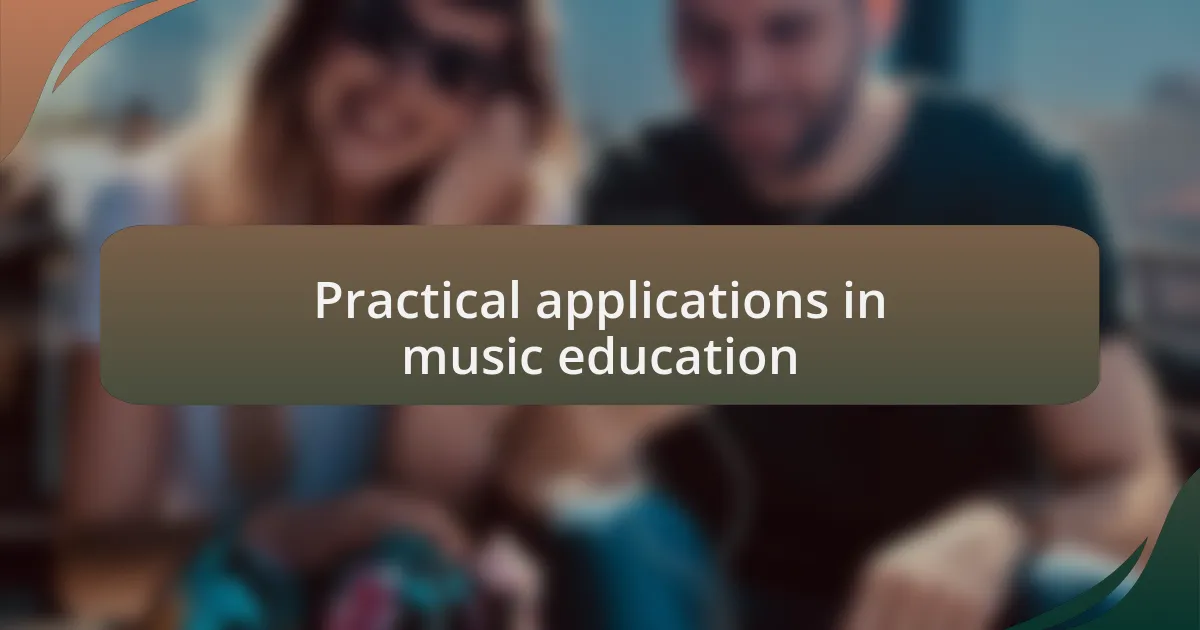Key takeaways:
- Analyzing classical music goes beyond notes and rhythms; it entails understanding emotional narratives, historical contexts, and the intentions of composers.
- Music education fosters creativity, discipline, and collaboration, enhancing both personal and social development in students.
- Active listening skills, such as identifying dynamics and emotional themes, are crucial for deeper engagement with music.
- Practical applications, including movement and technology integration, can significantly enrich students’ understanding and appreciation of classical compositions.

Understanding classical music analysis
Understanding classical music analysis involves more than just identifying notes and rhythms; it’s about unraveling the emotional language of the piece. I remember my first encounter with Beethoven’s Symphony No. 9. The sheer power of the ‘Ode to Joy’ made me question why it resonated so deeply within me. Was it the harmony, the dynamics, or perhaps the context of unity it embodies?
As I delved deeper into different interpretations, I realized that analyzing classical music requires a blend of intellectual curiosity and emotional engagement. Have you ever listened to a symphony and felt the ebb and flow of tension it creates? These fluctuations aren’t arbitrary—composers craft their music meticulously, and understanding their intent can transform a passive listening experience into a profound dialogue with the work.
In my own exploration, I’ve found that studying the historical context, structure, and stylistic elements can illuminate layers of meaning. For instance, recognizing how a composer’s cultural background influences their music enriches the analysis. Think about it: How does knowing the struggles of Chopin enhance your appreciation of his nocturnes? It’s in these connections that classical music becomes a living, breathing narrative we participate in, rather than just a collection of notes on a page.

Importance of music education
Music education is vital because it fosters creativity and critical thinking skills in students. I recall a class where we analyzed the intricate layers of a Mozart piece. As we worked through the music together, I witnessed how my peers began to think outside the box, connecting historical contexts to the emotional impact of the composition. It was incredible to see how these discussions sparked their curiosity and inspired them to express themselves musically.
Furthermore, learning about music promotes a sense of discipline and resilience. I remember practicing the piano for hours, struggling to master a challenging piece. Each mistake taught me patience and determination, skills that transcended the music room and positively impacted other areas of my life. Have you ever found that an intense focus on something can make everyday challenges feel more manageable?
Additionally, music education nurtures social skills through collaboration. In ensemble practices, we posed questions to each other about interpretations, helping each other grow as musicians. The joy of harmonizing or improvising together created a bond that was not just about music; it fostered a community. Don’t you think these connections are essential in today’s world, where collaboration and empathy are in high demand?

Basic elements of classical music
One of the fundamental elements of classical music is melody, which can evoke profound emotions and tell a story. I remember the first time I heard Beethoven’s “Moonlight Sonata” — the flowing, haunting melody swept me away, making me feel each note as if it were a brushstroke on an emotional canvas. Have you ever listened to a piece that resonated deeply within you, making you reflect on your own experiences?
Harmony is another essential component, providing depth and richness to a composition. I often find myself captivated by the way composers weave chords together, creating complex textures that shift the mood dramatically. For instance, when studying Brahms, I marveled at how he combined dissonance with consonance. It made me wonder how seamlessly these contrasts reflect the turbulence of human emotions — don’t you feel that music often mirrors the complexity of life?
Rhythm also plays a significant role in shaping the character of classical music. The precise beats and varied tempos can turn a serene piece into an exhilarating experience. I once participated in a workshop where we explored the intricacies of Tchaikovsky’s rhythm in “The Nutcracker.” The way those lively waltzes could transform the atmosphere reminded me that rhythm isn’t just about time; it’s about movement and energy. Doesn’t it fascinate you how a simple change in pace can alter our entire perception of a piece?

Techniques for analyzing compositions
When analyzing compositions, I often start by breaking down the structure. Many classical pieces follow specific forms, like sonata-allegro or rondo, which offer a blueprint for understanding the composer’s intentions. This reminds me of when I dissected Mozart’s symphonies; recognizing the patterns allowed me to appreciate the ingenuity behind his melodies. Have you ever noticed how these forms create expectations that heighten the listening experience?
Another technique I like to employ is identifying recurring themes and motifs within a piece. For instance, while studying Wagner, I became captivated by his use of leitmotifs, which are short musical phrases associated with particular characters or ideas. Recognizing these motifs transformed my listening experience, making me feel more connected to the narrative. Isn’t it fascinating how a tiny musical idea can unfold into a larger story throughout a composition?
I also pay close attention to orchestration and instrumentation, as they greatly affect the interpretation of a work. During a recent analysis of Mahler’s symphonies, I found myself in awe of how he utilized various instruments to evoke different emotions. The contrast between strings and brass, for example, creates a dialogue that mirrors human relationships. Don’t you love how orchestration can elevate a composition from mere notes to a vivid emotional landscape?

Developing listening skills in students
Listening is an active skill that requires practice and engagement, especially in the context of classical music. I remember my first experience taking a music appreciation class; the instructor encouraged us to close our eyes and truly immerse ourselves in the sound. This simple exercise revolutionized my auditory perception. Have you ever tried listening without any distractions? It can unveil layers of complexity that you might have missed otherwise.
As I guide students in developing their listening skills, I often suggest focusing on the dynamics of a piece. For instance, when I played Tchaikovsky’s “1812 Overture,” I found that the crescendos and decrescendos not only built tension but also elicited emotional responses. By asking students to identify moments when the volume shifts, I help them connect emotionally to the music. Why do you think those sudden changes can stir our feelings so deeply?
Another method I’ve found effective is encouraging students to identify the emotional themes within a composition. When analyzing Debussy, for example, I found that his impressionistic style sparks vivid imagery. I often ask students to visualize what they hear—what story does the music tell them? This approach not only enhances listening skills but also fosters a deeper personal connection to the music itself. Do you think that making these personal connections enhances our appreciation of classical music? I certainly believe it does.

Personal insights into my approach
When I analyze classical music, I often start by allowing myself to feel the emotions conveyed in the piece. For example, while listening to Beethoven’s “Moonlight Sonata,” I found myself swept away by the somber yet beautiful melodies. In moments like these, I encourage my students to tap into their own emotions and share what they feel; this openness can lead to profound discussions about the piece’s underlying narrative. Have you ever let a piece of music completely resonate with your feelings?
I believe that repetition is crucial in understanding classical compositions. During my early studies, I would listen to the same piece multiple times, each time discovering something new. For instance, with Bach’s “Goldberg Variations,” I was fascinated by how each variation told its own story while still relating back to the theme. How often do we take the time to revisit and delve deeper into the layers of a single work, only to uncover gems we missed before?
Furthermore, collaboration enhances my approach. I often organize group listening sessions where students can share their interpretations and insights. I recall a particularly lively discussion we had about Stravinsky’s “The Rite of Spring.” Each student brought their unique perspective, leading to a rich tapestry of ideas about its groundbreaking nature. Don’t you think that sharing interpretations can enrich our understanding of music, ultimately transforming the experience?

Practical applications in music education
In my experience, applying theoretical concepts to practical music education can deepen students’ understanding of the pieces they study. For example, when I introduced the concept of sonata form, I used Mozart’s “Piano Sonata No. 11” as a case study. By allowing students to identify the exposition, development, and recapitulation, they could practically see how these structures shape the emotional journey of the piece. Have you noticed how breaking down a large concept into digestible parts empowers learners?
Another approach that has worked wonders in my classroom is incorporating movement and visualization into music education. During a lesson on Tchaikovsky’s “Swan Lake,” I encouraged students to interpret the music through dance, which allowed them to physically express the music’s emotional nuances. I still remember how one student, who typically struggled with classical music, found her voice in movement. This made me wonder—how often do we overlook the power of physical expression in understanding music?
Finally, I often use technology to bring classical music to life. One time, I integrated an app that visualized sound waves while listening to Debussy’s “Clair de Lune.” Watching the waves ebb and flow alongside the music transformed an abstract concept into a visual experience, captivating students’ attention in a way traditional methods couldn’t. Isn’t it fascinating how technology can serve as a bridge between the auditory and the visual, enhancing our appreciation for classical compositions?